Vishwanath is another name of Lord Shiva, meaning The Lord of the Universe. It may refer to:

Nellaiappar Temple is a Hindu temple dedicated to the deity Shiva, located in Tirunelveli, a city in the South Indian state of Tamil Nadu. Shiva is worshipped as Nellaiappar represented by the lingam and his consort Parvati is depicted as Kanthimathi Amman. The temple is located on the northern banks of Thamirabarani River in Tirunelveli district. The presiding deity is revered in the 7th century Tamil Saiva canonical work, the Tevaram, written by Tamil saint poets known as the nayanmars and classified as Paadal Petra Sthalam.

Thiruparankundram Murugan Temple or Subramanya Swamy Temple is a Hindu temple and one of the Six Abodes of Murugan, located at Thiruparankundram. The temple is built in rock-cut architecture and believed to have been built by the Pandyas during the 6th century. According to the legend it is where Murugan slayed the demon Surapadman and married Deivayanai, the divine daughter of the king of heaven, Indra, and he is said to have worshipped Shiva here as Parangirinathar.
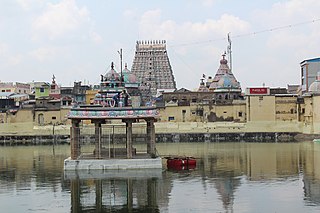
Adi Kumbeswarar Temple, Kumbakonam is a Hindu temple dedicated to the deity Shiva, located in the town of Kumbakonam in Thanjavur District Tamil Nadu, India. Shiva is worshiped as Adi Kumbeswarar, and is represented by the lingam. His consort Parvati is depicted as Mangalambigai Amman. The presiding deity is revered in the 7th century Tamil Saiva canonical work, the Tevaram, written by Tamil saint poets known as the Nayanmars and classified as Paadal Petra Sthalam.

Tirupperunthurai is located in Avudaiyarkoil, near Aranthangi in the Pudukkottai district of Tamil Nadu. It was built to honor Lord Shiva. One of the sacred books of Tamil Saiva Siddhanta, Manikkavasagar's Tiruvacakam, originated from this shrine. Manikkavasagar is said to have converted the king to follow Shiva, and built the temple with money that had been intended for war-horses.
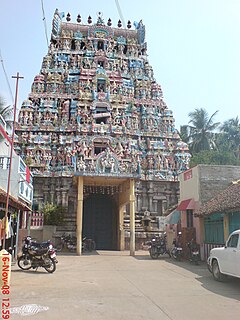
Kasi Viswanathar Temple, Kumbakonam is a Hindu temple dedicated to the deity Shiva, located in Kumbakonam, Tamil Nadu, India. Shiva is worshipped as Kasi Viswanathar, and is represented by the lingam. His consort Parvati is depicted as Visalakshi. The presiding deity is revered in the 7th century Tamil Saiva canonical work, the Tevaram, written by Tamil saint poets known as the nayanars and classified as Paadal Petra Sthalam.
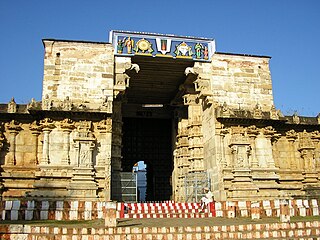
Vaishnava Nambi and Thirukurungudivalli Nachiar Temple in Thirukkurungudi, a village in Tirunelveli district in the South Indian state of Tamil Nadu, is dedicated to the Hindu god Vishnu. It is located 45 km from Tirunelveli. Constructed in the Dravidian style of architecture, the temple is glorified in the Divya Prabandha, the early medieval Tamil canon of the Azhwar saints from the 6th–9th centuries AD. It is one of the 108 Divyadesam dedicated to Vishnu, who is worshipped as Vaishnava Nambi and his consort Lakshmi as Thirukurungudivalli. The temple is locally referred as Dakshina Vaikuntam, the holy abode of Vishnu.

Uma Maheswarar Temple of Konerirajapuram in the Mayiladuthurai district in the South Indian state of Tamil Nadu, is a historical temple dedicated to Shiva. Shiva is worshiped as Uma Maheswarar, and is represented by the lingam and his consort Parvati is depicted as Mattuvar Kuzhalammai. The presiding deity is revered in the 7th century Tamil Saiva canonical work, the Tevaram, written by Tamil saint poets known as the nayanars and classified as Paadal Petra Sthalam.

Amirthakadeswarar Temple is a Hindu temple dedicated to the deity Shiva, located at Sakkottai in Tamil Nadu, India. The temple is dedicated to Shiva. Shiva is worshiped as Amirthakadeswarar, and is represented by the lingam. His consort Parvati is depicted as Amirthavalli Amman. The presiding deity is revered in the 7th century Tamil Saiva canonical work, the Tevaram, written by Tamil saint poets known as the Nayanmars and classified as Paadal Petra Sthalam.

Madavar Vilagam Vaidyanathar temple is a Shiva temple located in Madavar Vilagam, located in one kilometer southerly to Srivilliputhur in Virudhunagar district in the South Indian state of Tamil Nadu, is dedicated to the Hindu god Shiva. Constructed in the Dravidian style of architecture, the temple has two precincts. Shiva is worshiped as Vaidyanathar and his consort Parvati as Sivakami. The temple is the largest Shiva temple in the district. Shiva is worshipped as Vaidyanathar or the "God of healing". The holy water of the Siddhamirtham tank in the temple complex is believed to have curative effects, and a holy dip here is believed to cure all diseases. The temple was built by Thirumalai Nayak during the 16th century.

Soundararajaperumal Temple is a temple dedicated to Hindu god Vishnu, located in Thadikombu, a village near Dindigul in the South Indian state of Tamil Nadu. Constructed in Dravidian style of architecture, the temple is believed to have been built by Achyuta Deva Raya during the 16th century AD. Vishnu is worshiped as Soundararaja Perumal and his consort Lakshmi as Soundaravalli.
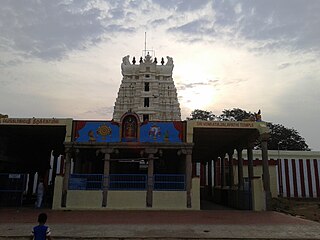
Krishnapuram Venkatachalapathy temple in Krishnapuram, a village in Tirunelveli district in the South Indian state of Tamil Nadu, is dedicated to the Hindu god Vishnu. It is located 10 km from Tirunelveli. Constructed in the Dravidian style of architecture, the temple is a storehouse of Nayak architecture.

Kailasanathar Temple in Srivaikuntam, a village in Thoothukudi district in the South Indian state of Tamil Nadu, is dedicated to the Hindu god Shiva. It is located 30 km from Tirunelveli. Constructed in the Dravidian style of architecture, the temple has three precincts. Shiva is worshipped as Kailasanathar and his consort Parvati as Sivakami. The temple is the sixth temple in the series of Nava Kailasams where the presiding deity of all the nine temples is Kailasanathar and associated with a planetary deity. The temple is associated with the planet Saturn.

Kasi Viswanathar Temple in Sivakasi, a town in Virudhunagar district in the South Indian state of Tamil Nadu, is dedicated to the Hindu god Shiva. Constructed in the Dravidian style of architecture, the temple is believed to have been built by Pandyan ruler Harikesari Parakkirama Pandian during the 16th century, with later additions from Madurai Nayaks. Shiva is worshipped as Kasi Viswanathar and his consort Parvathi as Visalakshi. The temple was the scene of temple entry movement in 1899, followed by Sivakasi riots when 22 people were killed.

Thiruporur Kandaswamy temple in Thiruporur, a panchayat town in Chengalpattu district in the South Indian state of Tamil Nadu, is dedicated to the Hindu god Murugan. Constructed in the Dravidian style of architecture, the temple is believed to have been expanded during the 18th century with the images excavated from Thiruporur.
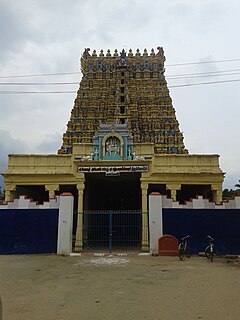
Sathya Vageeswarar Temple in Kalakkad, a village in Tirunelveli district in the South Indian state of Tamil Nadu, is dedicated to the Hindu god Shiva. It is located 45 km from Tirunelveli. Constructed in the Dravidian style of architecture, the temple has three precincts. Shiva is worshipped as Sathya Vageeswarar and his consort Parvathi as Gomathi.
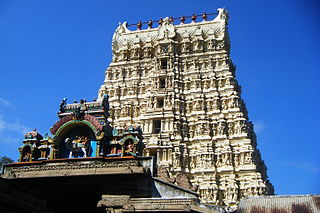
Papanasanathar Temple in Papanasam, a village in Tirunelveli district in the South Indian state of Tamil Nadu, is dedicated to Hindu god Shiva. It is located 60 km from Tirunelveli. Constructed in the Dravidian architecture, the temple has three precincts. Shiva is worshipped as Papanasanathar and his consort Parvathi as Ulagammai.

Balasubramaniyaswamy temple in Vennaimalai, a village in the outskirts of Karur in Karur district in the South Indian state of Tamil Nadu, is dedicated to the Hindu god Murugan. Constructed in the Dravidian style of architecture, the temple is located in the Karur - Pugalur Road. The legend of the temple is associated with Kamadhenu taking up the duties of Hindu god of creation Brahma and creating the hill of butter named Vennaimalai.

Thirumuruganatheeswarar Temple in Thirumuruganpoondi, a panchayat town in Tiruppur district in the South Indian state of Tamil Nadu, is dedicated to the Hindu god Shiva. Constructed in the Dravidian style of architecture, the present structure of the temple is believed to have been built during the Kongu Cholas period in the 10th century. Shiva is worshipped as Thirumuruganatheeswarar and his consort Parvathi as Avudainayagi.

Tenkasi Pandyas were the Pandya kings from Sadaavarman Parakrama Pandya to his successors who ruled with Tenkasi as their capital. With the invasion of the Sultanates, Vijayanagaras, and Nayakars from the fourteenth century onwards, the Pandyas lost their traditional capital of Madurai and shifted to cities like Tenkasi and Tirunelveli. Tenkasi was the last capital of the Pandyas. All the Pandyas from Sadaavarman Parakrama Pandya and his next generations were crowned in the Adheenam Mutt in Kasi Viswanathar temple. During the same period, some Pandyas ruled with Tirunelveli as their capital. Kayatharu, Vadakkuvalliyur, and Ukkirankottai are some of their major cities. Inscriptions on them are found in Tenkasi's Kasi Viswanathar temple, Brahmadesam, Cheranmadevi, Ambasamudram, Kalakkad and Pudukkottai. The last Pandyan king to be known in the history of the Pandyas was Kolakonda, who was also among the Tenkasi Pandyas.























